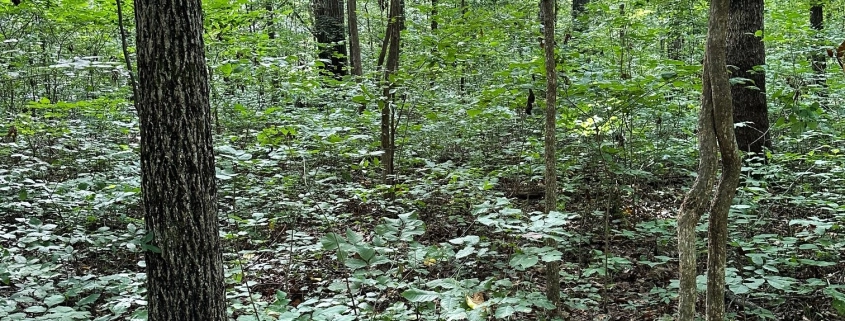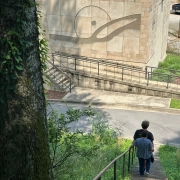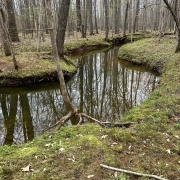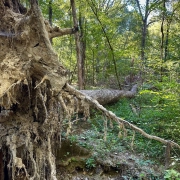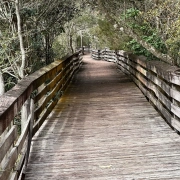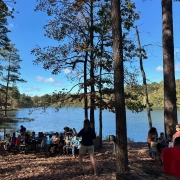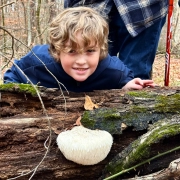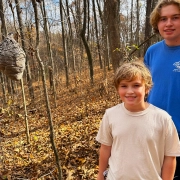What’s Happening in the Old Riparian Hardwood Forests that I Wander (and Wonder): Part Two
I offer Part Two of my examination of What’s Happening in the Old Riparian Forests, which I frequently explore at the nearby Wheeler National Wildlife Refuge. These forests date back to the 1930s when the TVA and Corps of Engineers acquired acreage destined for Wheeler Lake inundation and adjoining buffer lands associated with those properties. I set the stage for this essay last week with Part One: https://stevejonesgbh.com/2024/08/07/whats-happening-in-the-old-riparian-hardwood-forests-that-i-wander-and-wonder-part-one/
I have mentally labored on this Next Forest topic for several years as I’ve repeatedly bushwhacked through the riparian hardwood forests of the Wheeler National Wildlife Refuge, publishing a series of more than two dozen photo essays of my observations, reflections, photographs, and short videos beginning in January 2018. I begin this photo essay with several questions:
- Are these 90-year-old forests actively transitioning? Last week I answered, no.
- What factors will trigger a transition? What are the threshold criteria?
- When can we expect it to occur?
- How will we recognize it?
The Next Forest: When and What
I won’t speculate on when Nature will pressure the forest to cross the threshold. Without excess verbiage, I will chronicle the understory tree regeneration I recorded on July 6. Consider each individual as part of the next generation forest in reserve, banked and awaiting a threshold disturbance.
Future Subordinate Canopy Components
Redbud and sassafras are present in abundance. Redbud is a pioneer species, effectively occupying roadside edges, brushy meadows transitioning to forest, and newly disturbed forestland (storm or harvest). I’ve seen redbud emerge into the intermediate canopy but never into the upper reaches. Sassafras is another pioneer species. It occasionally reaches into the upper canopy, but I have never seen it rise to a dominant position. In sum, I would characterize redbud as a forest understory species and sassafras as an intermediate. Neither will be a major constituent of the next forest.
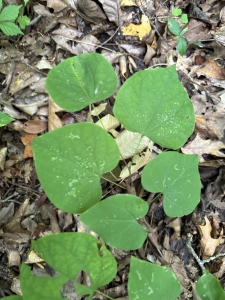
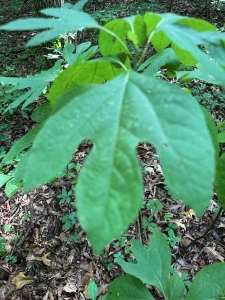
Muscadine awaits a major disturbance, full sunlight, and new tree transport into the next canopy. As peculiar as it may sound, muscadine will likely occupy the eventual emergent forest. Unlike the mighty oak that relies on its own devices to ascend to a dominant position, muscadine grasps oaks and other main-canopy-destined tree species, and gets a direct vertical transport. As the tree grows, the vine tags along into the ever-available full sunlight.
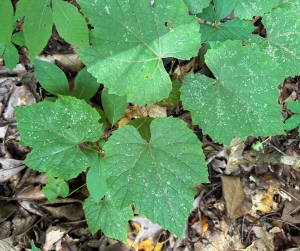
I found only a few individuals of parsley hawthorn and Atlantic poison oak. The parsley hawthorn is a small tree or shrub; the poison oak will seldom exceed 3-4 feet. Both will be present in the understory of the next forest.
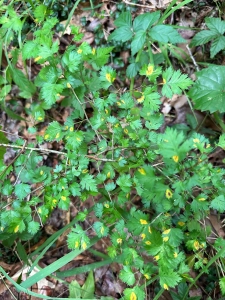
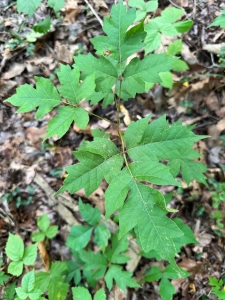
Red buckeye and paw paw appeared sporadically. They both are normally present in the understory, although I have seen paw pay in the mid-story.
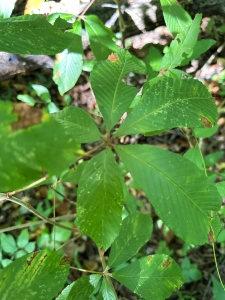
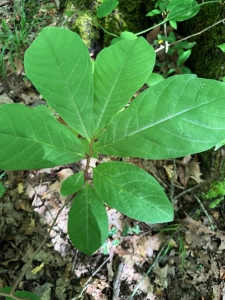
Ironwood (Ostrya virginiana) stands ready to assume a mid-canopy position in a new forest. I have never observed it in a main canopy.
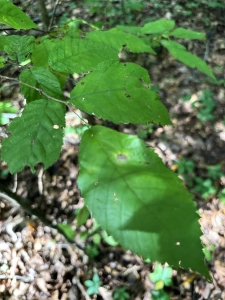
I am certain that I missed many other woody species; don’t view my listing as exhaustive.
Future Dominant Canopy Components
With the exception of muscadine, the above documented species will not occupy the main canopy of the next Refuge bottomland hardwood forest. I’ll now review some species I photographed on July 6 that will dominate the overstory. Yellow poplar and sweetgum are poised to mine sunshine post-disturbance. I estimate that together sweetgum and yellow poplar account for 10-15 percent of the current main canopy stocking. I base my estimates on observations and not measurements, a luxury afforded old geezers who are not authoring refereed scientific journal articles!
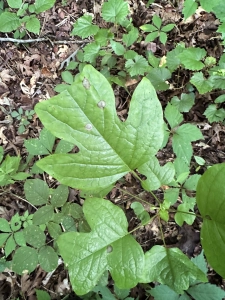
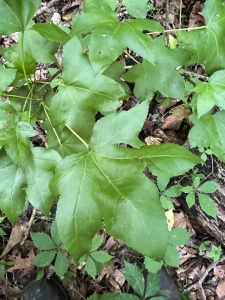
Red maple may constitute five percent of the present overstory.
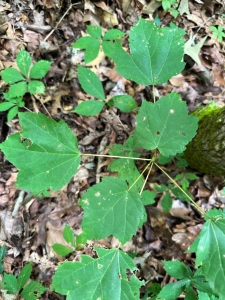
Green ash seedlings cover the forest floor in a few areas, but the species represents perhaps five percent of the main canopy.
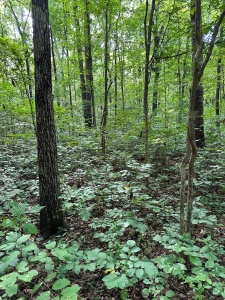
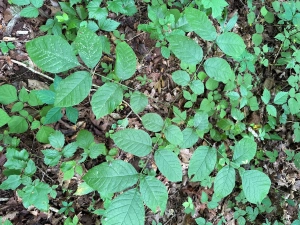
I saw little advanced regeneration on the forest floor in much of the seasonally-inundated soils.
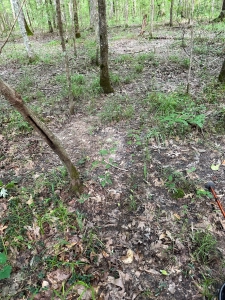
Willow oak and water oak seedlings less than two-feet tall dotted these wet sites; the seedlings below are willow oaks. I will not attempt to separate the existing main canopy distribution by individual oak species. Instead, I estimate that all oak species combined (principally northern and southern red; willow and water; cherry bark; chinkapin; white) constitute 50 percent.
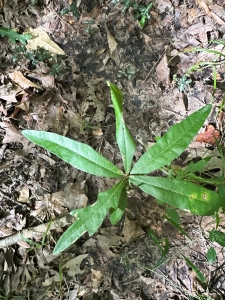
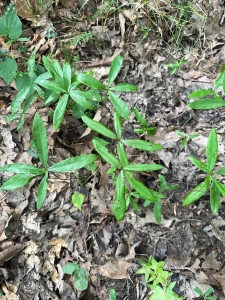
This is chinkapin oak. I found no red, white, or cherry bark oak seedlings. Allow me to repeat a qualification to these observations and reflections. Were I still a practicing forest scientist seeking refereed journals to publish my results, I would conduct rigorous field surveys to quantify current stand composition and systematically inventory advanced regeneration. However, I am a retired, 73-year-old Nature enthusiast, who seeks to ponder questions of his own design, and proffer answers and speculations to share with others.
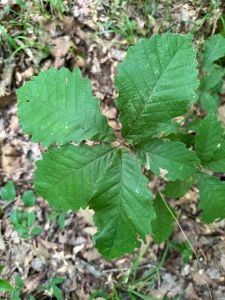
Hickory species account for 20 percent of the current stocking, predominantly shagbark. This is one of the few hickories I found.
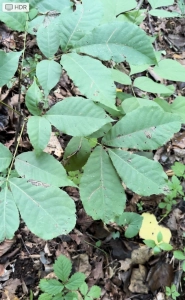
Although the overstory has a few American beech, black cherry, and sugarberry trees, my July 6, trek encountered no individuals on the forest floor. A single loblolly pine seedling appeared within my sight. Together, I estimate that these four species represent no more than five percent of the bottomland forest overstory.
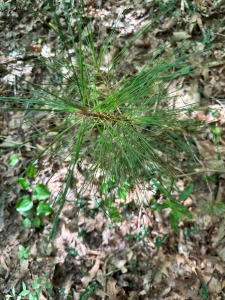
I am certain that when I next visit this forest I will see a main canopy species or two that I failed to include in this discussion. I don’t believe that such omission will discredit any of the reflections and conclusion I am about to share with you.
Summary and Conclusions
First and foremost, the forest is changing. Individual main canopy tree are succumbing to wind, lightning, and the associated effects of decay and weakening. Not a single one of these individual trees dying or toppling, even those that occupied large aerial spaces (up to one-fifth acre), is encouraging colonization of the affected forest floor by tree regeneration. Nearby trees expand their crowns rapidly into the resultant canopy void, effectively limiting sunlight reaching the forest floor to a time period insufficient to permit regeneration to establish and develop. Simply the level of disturbance and rate of attrition are not triggering an obvious transition to a new forest.
What will it take to trigger the transition to a new forest? I know from my work in northern hardwood forests that an essential transition factor is not apparent in our Refuge bottomland forests. There is no shade tolerant intermediate vertical tier of trees (in the north: American beech; yellow birch; sugar maple; and eastern hemlock) positioned to emerge into the upper canopy when large individual and clusters of main canopy trees die or fall. As I observed in Part One, these stands have an understory of subordinate woody trees, but no intermediate structure of future main canopy emergent species.
I am convinced that without a major disturbance (to include: tropical systems transporting wind north from the Gulf; derechos; microbursts; tornados; severe ice storms), the forest will continue to lose individual trees. Remaining trees will capitalize on the crown voids and add girth. We’ll observe fewer trees per acre. The average diameter of the residuals…the survivors…will increase rapidly on these extraordinarily fertile moist soils. Keep in mind that, like all living organisms, trees have finite life spans.
Eventually, a force will trigger renewal. Nature abhors a vacuum. Full sunlight on the forest floor will stimulate all of the species chronicled above. Other bird-disseminated and windblown seed species will find purchase and germinate. A new forest will emerge. Time and intense competition will sort the winners and losers. Nature won’t allocate space by some artificial construct like diversity, equity, and inclusion. Performance will determine the nature, structure, and composition of the new forest. My guess is that ninety years from that critical trigger event, the forest will look a lot like the one where I wonder and wander.
Thoughts and Reflections
I offer these observations:
- Nature sleuthing involves seeing, understanding, and appreciating what lies hidden in plain sight.
- First and foremost, the subject forest is changing…but not yet transitioning to a new forest.
- It is difficult to make predictions, especially about the future. (Attributed to Yogi Berra)
- My observations, reflections, and predictions are science-informed…and far from clairvoyant!
Inhale and absorb Nature’s elixir. May Nature Inspire, Inform, and Reward you!
Note: Unless otherwise noted, all blog post images are created & photographed by Stephen B. Jones. Please circulate images with photo credit: “©2024 Steve Jones, Great Blue Heron LLC. All Rights Reserved.”
Another Note: If you came to this post via a Facebook posting or by another route, please sign up now (no cost… no obligation) to receive my Blog Post email alerts: http://eepurl.com/cKLJdL
And Third: I am available for Nature-Inspired Speaking, Writing, and Consulting — contact me at steve.jones.0524@gmail.com
A reminder of my Personal and Professional Purpose, Passion, and Cause
If only more of us viewed our precious environment through the filters I employ. If only my mission and vision could be multiplied by untold orders of magnitude:
Mission: Employ writing and speaking to educate, inspire, and enable readers and listeners to understand, appreciate, and enjoy Nature… and accept and practice Earth Stewardship.
Vision:
- People of all ages will pay greater attention to and engage more regularly with Nature… and will accept and practice informed and responsible Earth Stewardship.
- They will see their relationship to our natural world with new eyes… and understand their Earth home more clearly.
Tagline/Motto: Steve (Great Blue Heron) encourages and seeks a better tomorrow through Nature-Inspired Living!
Steve’s Three Books
I wrote my books Nature Based Leadership (2016), Nature-Inspired Learning and Leading (2017), and Weaned Seals and Snowy Summits: Stories of Passion for Place and Everyday Nature (2019; co-authored with Dr. Jennifer Wilhoit) to encourage all citizens to recognize and appreciate that every lesson for living, learning, serving, and leading is either written indelibly in or is powerfully inspired by Nature.
I began writing books and Posts for several reasons:
- I love hiking and exploring Nature
- I see images I want to (and do) capture with my trusty iPhone camera
- I enjoy explaining those images — an educator at heart
- I don’t play golf!
- I do love writing — it’s the hobby I never needed when my career consumed me
- Judy suggested my writing is in large measure my legacy to our two kids, our five grandkids, and all the unborn generations beyond
- And finally, perhaps my books and Blogs could reach beyond family and touch a few other lives… sow some seeds for the future
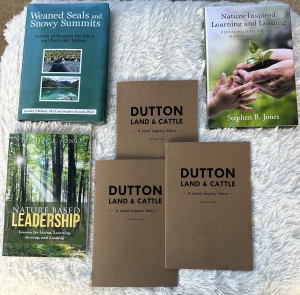
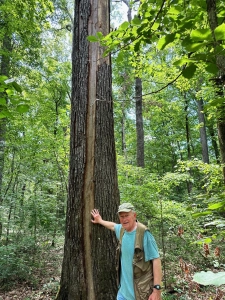
All three of my books (Nature Based Leadership; Nature-Inspired Learning and Leading; Weaned Seals and Snowy Summits) present compilations of personal experiences expressing my (and co-author Dr. Wilhoit for Weaned Seals and Snowy Summits) deep passion for Nature. All three books offer observations and reflections on my relationship with the natural world… and the broader implications for society. Order any from your local indie bookstore, or find them on IndieBound or other online sources such as Amazon and LifeRich.
I now have a fourth book, published by Dutton Land and Cattle Company, Dutton Land & Cattle: A Land Legacy Story. Available for purchase directly from me. Watch for details in a future Post.

